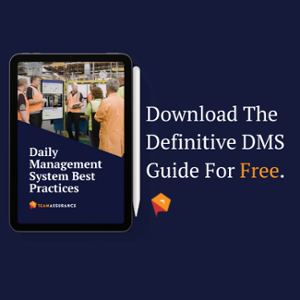Continuous Improvement Planning: A Key Step

As the old adage says – if you fail to plan, you plan to fail. In the world of continuous improvement having a plan at each step and at each level is a must. A plan ensures any activity is considered and executed to a standard that optimises the inputs and the outcomes. This is a fundamental step where most individuals, teams and organisations fail to capitalise on the opportunity presented.
Not through the will or the desire to make positive change, but through neglecting to take the time to clarify, document, structure and understand the requirements of the journey towards the objective(s).
Keep continuous improvement planning simple
Planning does not need to be a complex process. It should be a simple, accessible and inclusive activity that produces a tangible map to focus and guide people. The word itself can send people into a cold sweat and panic. Statements like, ‘I don’t know how to plan’, ‘I’m not good at planning’, or ‘It’s only bosses who make plans’ can often be heard when announcing a planning activity.
The volume of wasted time, energy and resources in organisations through poor planning or no plan at all is significant. It speaks to the dichotomy of busyness versus effectiveness. We can often dive in, deploy resources, jump to conclusions and solutions feeling we are doing something positive. However, without a plan in hand we are simply hoping for the best. There is an appearance of things happening yet any achievements will be gained through good luck rather than by good design.
Conversely, we simply do nothing; constrained by overthinking and overanalysing the situation. We become stuck in a state of inertia. We don’t know what to do due to a lack of clarity regarding the current state or why we need to move toward a specific objective or process condition.
It all comes back to PDCA
A plan creates a standard and an expectation, it allows us to track and measure our progress and to celebrate milestones along the way. Plans can and should evolve as they progress; serving as a learning and reflective tool with regular cycles of review. The Plan Do Check Adjust (PDCA) cycle of improvement essentially starts and ends with Plan.
The Plan component is where we establish the justification or the need to take action, or to do something differently. This stage ensures we stop to consider (and understand) the current state as well as the target condition. We essentially define the problem or objective and create / illuminate the road ahead.
Take an A3 project plan in TeamAssurance for instance. All relevant actions, accountabilities, activities and timings within a given project are visible in a click. The path forward is illuminated and there can be certainty the information needed to check our adherence to the plan will be there for review at regular intervals.
The planning process can play out in five minutes on the frontlines of the organisation, scrapped out on a piece of paper. It can also play out over days and weeks in the boardroom, developing a strategic direction over the long term. The point is that having a documented direction, with clear next step(s) that describes what we want to achieve, by how much, by when, and by who provides something tangible and meaningful for people to work toward.
Communication is key to executing on the plan
A well articulated and communicated plan supports alignment. It enables individuals and teams to make the appropriate decisions and adjustments along the way. Good planning and a culture of open communication creates an environment of safety and stability where the cadence is set, the thinking is proactive and consultation / inclusion is a primary consideration. Planning by its nature should also incorporate the collective experience and learning of a team or organisation.
Each subsequent plan should have some basis on the reflections of a previous planning cycle. As stated, a plan could be designed for the next hour or it could be designed for the next 5 years - and every timeframe in between.
Planning helps us to prioritise and to build accountability into the day-to-day. Without a clear plan our objectives are nothing more than good intentions. How many new year’s resolutions last longer than March?
When there is nothing substantial to underpin the intentions we fall into failure and mediocrity by not considering or clarifying the objectives and the required activity appropriately. The right tools can make comprehension and acceptance of the plan easy.
A plan requires structure and it is a tool that keeps us on course, on time and like any other standard helps us to expose the waste and deviation in the process.
In TeamAssurance, ju as the A3 project plan above lays out key activities in a dynamic format we can visualise the overarching key objectives via the Goal Tree:

At a glance teams can understand how our activities link together and who is accountable. Plus we can click into each item to learn more or provide input. This is critical; a plan must be documented and visible to be an effective tool with which to deploy our resources.
Don't forget, a plan can take many forms in the Lean world. It could be:
- Leader standard work
- A production schedule
- A quick changeover procedure
- A meetings objectives and agenda
- A short cycle improvement or problem-solving exercise
- A Hoshin or Strategy deployment document
- A daily plan formulated at a daily huddle meeting
- A response to a process deviation through A3 problem solving
Deming said that, ‘Without data you are just another person with an opinion.’ Without a plan we are just another person or team with a bunch of hope and unrealised aspirations. Planning is something that takes practice and discipline – but without a plan we are rudderless at sea.
Don't plan in isolation - Get a view of the greater C.I. framework
To make the most of the items above, we must ensure that they are built with adjacent processes and systems in mind. Leader Standard Work and Daily Huddles must be supported by standardised problem solving techniques, and documented Standard Operating Procedures (SOPs).
The goal is to build Tiered Daily Management process that can handle the full PDCA loop to deliver the desired continuous improvement. To achieve this we must ensure that no element of the greater C.I. Framework is orphaned or developed in isolation.
The illustration below shows how we designed an interconnected platform that ensures there are no disconnected ‘Point Solutions’ (digital or analog) that can hinder organisations from achieving their objectives.

Set a course and steer the organisation in the right direction with a platform for Strategy, Project and Daily Management. Learn more about TeamAssurance by booking a platform discussion today.


